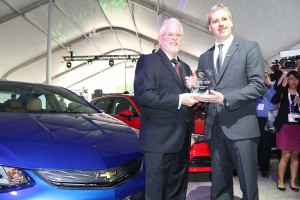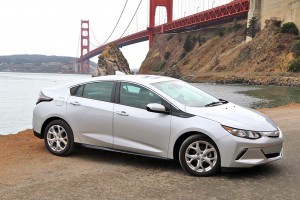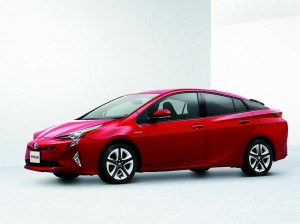The completely redesigned 2016 Chevrolet Volt has been named Green Car of the Year, repeating a victory it claimed when the original plug-in hybrid debuted a half-decade ago.
The Volt knocked down an impressive list of competitors that included the new, fourth-generation 2016 Toyota Prius, the world’s best-selling hybrid-electric vehicle.
“This is certainly something special,” proclaimed Steve Mojoras, Chevy’s marketing manager, after accepting the crystal trophy at the L.A. Auto Show event. “This is a hard market to crack. This is the Super Bowl of green car awards, so it adds instant validation.”
The original Volt was the industry’s first mass-market plug-in hybrid, offering buyers more than 30 miles of range per charge before firing up its internal combustion engine. The new model migrates to a new, lighter chassis, adopts a smaller but more powerful battery pack that allows it to now squeeze in five passengers, rather than four, and boosts range to 53 miles per charge.
Those were all key factors in the decision by a jury that includes a variety of green car specialists, a former chief of the California Air Resources Board, environmentalist and ocean activist Jean-Michel Cousteau, and comedian and car fanatic Jay Leno.
The upgrades to the second-gen Volt came as “a bold statement of what can be achieved when you listen to the voice of the customer,” explained Ron Cogan, the award’s organizer and publisher of the Green Car Journal.
(Click Herefor a review of the 2016 Chevrolet Volt.)
The four other finalists included:
- The 2016 Toyota Prius, the wildly popular hybrid that has also gone through a complete makeover. Among other things, the new Prius has boosted its fuel economy by about 10%;
- The 2016 Honda Civic, the dominant player in the compact car market, also redesigned for 2016. It was the only finalist without a battery-based option;
- The 2016 Hyundai Sonata, the Korean midsize sedan now offered with a high-mileage gas engine as well as both a plug-in and a standard hybrid option; and
- The 2016 Audi A3 Sportback e-tron, the maker’s first U.S. plug-in hybrid model. Audi has promised it will be the first of an expanding range of “electrified” vehicles.
(Toyota wants to eliminate the internal combustion engine. Click Here for the story.)
The Green Car of the Year jurors have often bucked industry trends, giving their nod to diesel vehicles, for example, when hybrids had become the darling of the environmental community.
Among other things, Cogan stressed, the award is meant to honor the somewhat intangible “fun-to-drive” factor that many early green machines were short on.
“It isn’t just about fuel economy and emissions,” he said, “It’s also about the joy of driving.”
The choice of the Chevrolet Volt as Green Car of the Year “is a big deal for us,” General Motors global product development chief Mark Reuss told TheDetroitBureau.com.
The Detroit maker has put a strong emphasis on “electrification,” and plans to bring out a 200-mile range model, the Chevy Bolt, a year from now.
The original Volt got a strong launch but soon lost market momentum, sales tumbling sharply over the last several years.
Company officials say they will be making the new Green Car award a centerpiece of their 2016 Chevrolet Volt marketing campaign.
(Click Here for complete coverage of the 2016 LA Auto Show.)




The true name of this award is “Anything Not a Prius.” The award history is the ‘kiss of death’ because so many earlier winners have all but died in the market. The “Green Car of the Year” has the credibility of “Clean Diesel” . . . an earlier award winner.
Customers are voting with their wallets and the Prius continues to dominate.
Bob Wilson, Huntsville, AL
The car pictured is blue and I guess from his comment that Bob is also blue that the penis didn’t win the award this year. LOL
People voting with their wallets are buying ICE powered vehicles for obvious reasons. EV’s don’t even constitute one percent of sales world wide. The combined sales of all EVs sold in recent times just surpassed 1 million units this year. As the bloke stated, “this is a tough market to crack” …because few people desire an EV, for obvious reasons such as high cost, short range and a lack of charging stations. Some folks are just slow to get in touch with EV reality. Being an EV cheerleader doesn’t change reality.
BTW, why do so many penis owners speed when driving on the roadways? Are they desperately looking for a charging station? Just wondering…
GT, as you and regular readers know, I am a “skeptical proponent” of battery technology. While it’s true battery vehicles were around early on the tech was not competitive and effectively went into a century’s hibernation. That battery-based vehicles, from mild hybrids to full EVs even have 4-5% of the U.S. market in recent years might alternately be seen as impressive v a sign of failure. Do I think vehicles like the Mitsubishi i-MiEV,Nissan Leaf or Chevy Volt will take over the world? Nope, not in current form. But despite the fact that I am not a huge fan of the vehicle one cannot just write off the fact that the Toyota Prius has not only been the #1-selling hybrid but also the most popular vehicle of all in Japan and, in several recent years, California’s best-seller.
We can get off on a tangent and talk about regulators and questionable market distortions and so on, but give the public an affordable battery that can deliver range and performance and charge in reasonably short order and you MAY see things evolve more than you expect.
There have been plenty of historical cases of new technology not being taken seriously and then suddenly transforming everything. Will batteries, or fuel-cells, be another example? I think we make a mistake if we write them off in knee-jerk fashion.
Paul A. Eisenstein
Publisher, TheDetroitBureau.com